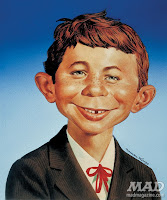Is this pathetic or what? Someone else offers to write a ranty blog post for me and I still can’t get it up on time. It’s sad, really…
Well, here’s Thom Brannan, author of
Lords of Night and (with DL Snell) co-author of
Pavlov’s Dogs and their new book
The Omega Dog, talking a bit about clarity. I’ll be back later this week (hopefully on time) to talk about Easter eggs.
——————————————
Hello is alright, again. On occasion, Pete has stuff to do; like, a lot of it, and he knows there are a lot of you who come to this blog for tips and tools.
So this week, it’s me again. Thom Brannan. I’ll try to avoid disappointing you. Those of you who know who I am, congratulations! For those who don’t, here is a picture.
For your readers who are just like you, no doubt this will be a source of delight and entertainment. But not everybody is like you. For those readers, this will induce the effect known as “God, I’m skimming this part.” It happens.
Let me hit you with an example. I recently finished reading something by Robert A. Heinlein. He’s one of my literary heroes, okay? I love his work and his verve and his ideas and just everything.
Almost.
I’m now catching up on works of his I’d missed previously, and it’s great joy. Except when he devotes entire paragraphs to doing math. Really, honestly, when I started reading his stuff, it made me want to run out and get a slide rule, just so I could keep up. True story. But that was a different me, back in high school. Math was one of my things. Now, when I get to a part where any of his hyper-competent characters go on about anything that remotely resembles figuring, I just skim over it.
But that wasn’t enough to spark this blog entry. I’m also reading a WWII story about… well, about spooky stuff. (I don’t want to put too fine a point on what or who I’m reading.) So, there’s a passage where some dirty, nasty Krauts are in a plane with a creepy box which may or may not have something moving in it, and the author is clearly enamored with the plane. With the plane. There is
a serious chunk of text dedicated to the plane and why it was chosen for this type of mission and the capabilities of the plane and how it got its nickname, et cetera.
 |
This will cost you
extra with FedEx |
But what about the spooky box?
The spooky box, if I’m reading the foreshadowing correctly, contains something (someone?!) which is going to be major later on, and next to no text is dedicated to it. It’s just kind of there, and the Nazis eye it, and the plane they’re in is endlessly fascinating.
Now, in other places in this very blog, Pete has said things like have
a reason to describe it, or to avoid being
focused on the wrong thing. Sometimes, it’s hard to figure out when YOU’VE LOST YOUR
GODDAMN… excuse me. Sometimes it’s hard to know when the thing you’re writing is what people need to read about the story. Or if people will even read it. Skimmers gonna skim.
For an easy litmus test, corner someone your work with. Or someone you live with. Or someone in the grocery store. Whatever. Start telling them all this cool stuff you’ve unearthed about maybe Einstein being a plagiarist, or the use of Tesla technology to cripple other nations, or how the innards of a watch work, or how the Warthog got its nickname of the Warthog, or whatever stupidly addicting thing you’re bound and determined to include in your current or next work.
 |
| This is what it’s like… |
And since I didn’t say this from the get-go, this is what I’ve found works for me. I have a relatively diverse background, and I find a lot of things fascinating. But only a fraction of that stuff finds its way into my prose because I’ve seen the look in people’s eyes, that loss of focus when they’re not really listening to me anymore. It happens quite a bit, as I tend to ramble.
For instance, in my most recent work,
The Omega Dog(with D.L. Snell) there’s a section where the protagonists travel in the Gulf of Mexico in a narco-sub. I’m a former submariner, and the intricacies of the works of subs, even the fiberglass jobs used to transport drugs, kind of trips my trigger. So I sat and wrote maybe two pages of all this, and then I stopped.
There was also a drug lord, my protagonists, a person who may or may not have been human, a strapped-down zombie and a goddamn WEREWOLF, all in this tiny space… and here I was writing about navigation and whatnot. A little bit of submarine development history had made it in there, too. What the hell?
I deleted all that before I sent it to Snell, because he would just delete it. He’d be nicer about it than I was to myself, but the end result would be the same.
There are exceptions, of course. What’s his name, the legal writer guy? The one who wrote
The Pelican Brief. He leaves a lot of that stuff in there because hey, that’s what his readers are reading him for. The same
with gun porn. I mean, men’s adventure. My good friend Doug Wojtowicz knows a lot about guns, and that kind of detail is not only expected in
The Executioner, but welcome. God help him if he leaves something out. Or gets it wrong, yikes.
But I guess I’m starting to get long-winded. Shaddap. I guess my point is this: if you’re including something like that, be sure it moves the story along, or is at least an interesting tangent with some story elements to it. If at any point, your manuscript starts to read like a Wikipedia entry, you’re doing it wrong.
So there. My two cents. Again, your mileage may vary.
Go write something.
 Check out this little diagram. Here’s a pair of timelines featuring two characters from Doctor Who—the Doctor himself and his friend, Jack Harkness. There’s kind of a big spoiler in here (or not, depending on which fan theories you subscribe to) which I’ll try to avoid, but if it makes things too confusing just say so.
Check out this little diagram. Here’s a pair of timelines featuring two characters from Doctor Who—the Doctor himself and his friend, Jack Harkness. There’s kind of a big spoiler in here (or not, depending on which fan theories you subscribe to) which I’ll try to avoid, but if it makes things too confusing just say so. In fact, this linear order creates a big twist for the Doctor (and the viewers, since we’re following him). He doesn’t realize the person he first meets at D is the same person he later meets at A (as I mentioned, a lot of time passes for Jack). But this isn’t a twist for Jack because he’s following his own linear story. That’s why he can address the (somewhat confused) Doctor as “my old friend.”
In fact, this linear order creates a big twist for the Doctor (and the viewers, since we’re following him). He doesn’t realize the person he first meets at D is the same person he later meets at A (as I mentioned, a lot of time passes for Jack). But this isn’t a twist for Jack because he’s following his own linear story. That’s why he can address the (somewhat confused) Doctor as “my old friend.” 









